ASRock A75 Extreme6 Review and Desktop Llano Overclocking
by Ian Cutress on June 30, 2011 12:05 AM ESTLAN Speed Test
LAN Speed Test is a freeware program designed for testing the network connection between two PCs on a home network. The speed of the transfer is limited by the lowest common denominator on the network, so if you have gigabit Ethernet capable computers but a 100 Mbit capable router, you are limited to 100 Mbit transfer. Note that this is really a formality – if a network port is rated at 1 Gbps, then chances are that it will hit at least 90+% of this value. The main test here is CPU usage, and how much is offloaded by the controller. For this test, we use LAN Speed Test to transfer a 1000 MB file across a home network with a 100 Mbps lowest common speed to the same machine each time, in a read/write scenario. CPU usage is taken as a visual max/average from task manager.

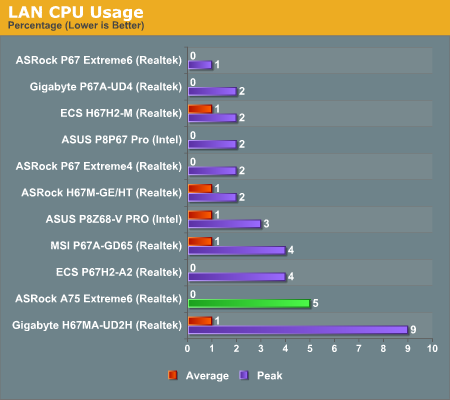
USB Speed
For this benchmark, we run CrystalDiskMark to determine the ideal sequential read and write speeds for the USB port using our 64GB Patriot SuperSpeed USB 3.0 drive. Then we transfer a set size of files from the SSD to the USB drive, and monitor the time taken to transfer. The files transferred are a 1.52 GB set of 2867 files across 320 folders – 95% of these files are small typical website files, and the rest (90% of the size) are the videos used in the Sorenson Squeeze test.
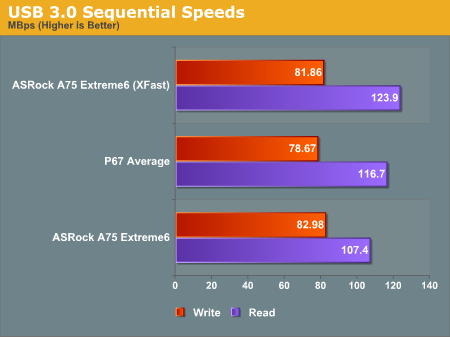
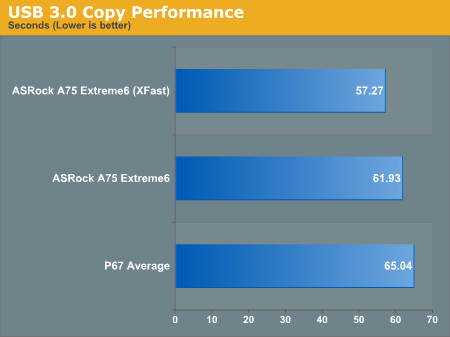
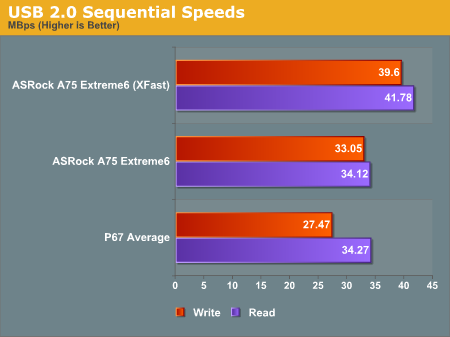
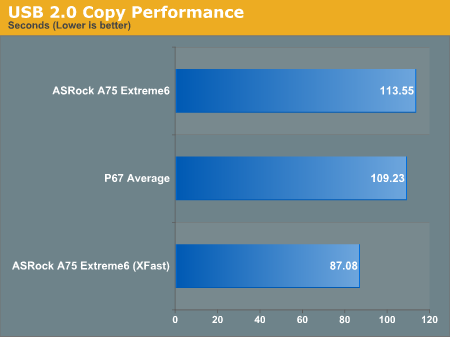
SATA Testing
We also use CrystalDiskMark for SATA port testing. The operating system is installed on the Micron RealSSD C300, which is rated at 355 MB/s read and 215 MB/s write, and the sequential test is run at the 5 x 1000 MB level. This test probes the efficiency of the data delivery system between the chipset and the drive, or in the case of additional SATA ports provided by a third party controller, the efficiency between the controller, the chipset and the drive.
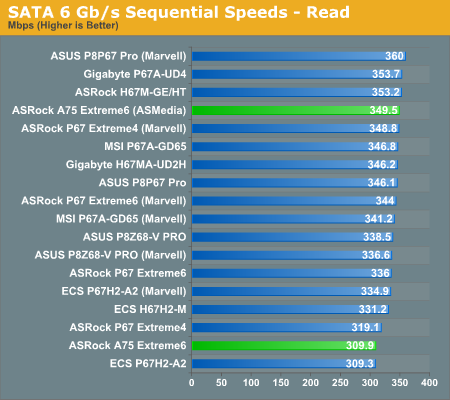

DPC Latency
Deferred Procedure Call latency is a way in which Windows handles interrupt servicing. In order to wait for a processor to acknowledge the request, the system will queue all interrupt requests by priority. Critical interrupts will be handled as soon as possible, whereas lesser priority requests, such as audio, will be further down the line. So if the audio device requires data, it will have to wait until the request is processed before the buffer is filled. If the device drivers of higher priority components in a system are poorly implemented, this can cause delays in request scheduling and process time, resulting in an empty audio buffer – this leads to characteristic audible pauses, pops and clicks. Having a bigger buffer and correctly implemented system drivers obviously helps in this regard. The DPC latency checker measures how much time is processing DPCs from driver invocation – the lower the value will result in better audio transfer at smaller buffer sizes. Results are measured in microseconds and taken as the peak latency while cycling through a series of short HD videos - under 500 ms usually gets the green light, but the lower the better.
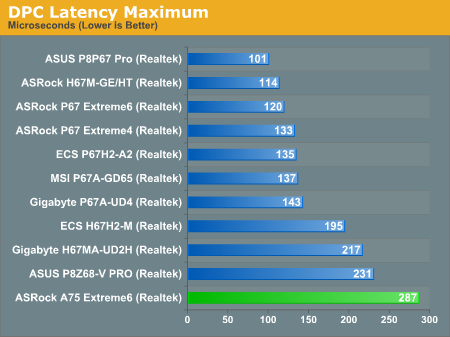










44 Comments
View All Comments
mino - Thursday, June 30, 2011 - link
"The question now becomes, is Desktop Llano worth the extra $75?"I keep wondering how much it cost to get you to claim Llano is 1/3 more expensive that i3 ?
REALLY ???
1) I do not remember you comparing _whole_platform_cost_ when reviewing Intel chips against AMD, at a time when there was a $30 Intel mobo tax in place.
2) Taking one of the highest-end Llano mobos with the highest-end Llano chip and comparing it price-wise to lowest-end SB (which it thoroughly trounces in everything besides single-threaded pure CPU loads) coupled to a low-end SB mobo? REALLY?
Shame.
L. - Thursday, June 30, 2011 - link
Eh .. sometimes bias is so visible, I'm not the only one to react anymore ;)But they do it every day... if anyone remembers the Xeon e7 review, where AT clearly showed that a 45nm Opteron was better in perf/watt than a 32nm Xeon ... biggest fail ever on the part of Intel that (they had same efficiency within 2% at full load, but reality is not full load :p ).
Even Tom's Hardware, which was Intel sponsored since the day it was sold wasn't even half as hard on the Llano as you guys ....
The one good info anyone can get out of this is that Intel is afraid of Llano and they're ready to pay a lot to get it slandered... one more reason to buy it, if Intel thinks it's great :)
whatthehey - Saturday, July 2, 2011 - link
No, you're not the only one to "react". You and all your asshole AMD luvin' fanboys from AMD zone or wherever are all over every one of the recent AMD articles on this site. Llano is an inexpensive APU that fails to impress. It's not bad, but for what it delivers? PLEASE!Overclocking? Intel wins by such a huge margin it doesn't even matter.
HTPC? Llano is buggy right now. Your best bet is a discrete GPU for serious HTPC use, and as long as you're getting a discrete GPU, you should buy the better CPU to go with it. Guess what, Intel wins again.
Gaming? Get a fucking clue, L. and duploxx. AMD has some great GPUs, but Llano is barely good for entry level gaming. No one that really cares about gaming is going to be impressed by something that matches a $35 dGPU.
General performance? Intel wins. Doesn't matter if it's SYSmark, PCMark, Sunspider, or some other test -- Intel has a substantially faster CPU architecture.
Pricing? Right now, AMD even loses this. Sure, you can get AMD systems for less than Intel systems, like if you get last-gen AMD. The Llano stuff right now is too expensive on the motherboard side to beat Core i3 and Pentium. When motherboard production ramps up, AMD and Intel will still be very nearly tied on pricing for low-end parts. Hooray!
3DMark. AMD wins in the IGP battle! Who cares about 3DMark? L. and duploxx and a bunch of other retarded AMD bigots who drink the AMD kool-aid and quote AMD PR like a bible.
In summary: everyone with half a brain can see the AMD Llano articles at Anandtech for what they are: factual representations of performance showing that AMD only wins on graphics, and only against IGP. Llano is only going to impress the dimwitted folks that slobber over every AMD release. Those who look for the best system will stay away, but I'm sure Best Buy will sell lots of these Llano systems to people that really have no idea what hardware is inside and don't care one way or another.
Snotling - Thursday, June 30, 2011 - link
"Tomorrow's technology today" they say... Seing as the Board has 3 "legacy" oh, no let me use "outmoded" PCI slots, I would call that "Yesterday's technology in store tomorrow"Who ever needs more than 1 PCI slot anymore? I can easily live with NONE.
But still they keep on designing boards with 2 and 3 of those... try finding a board with a 4x or 8x PCI-E for a RAID Add-on, almost non-existent unless you go for a server board.
This is supposed to be a higher end product for enthusiasts and I'm really NOT enthusiastic about NOT having a PCI-E 4x expansion on it.
dczyz - Thursday, June 30, 2011 - link
Just picked up a ASUS P8Z68-V PRO and was very disappointed with the lack of support for the Server 2008 based OS's.Since Server 08 is being used in Home Server, and Small Business I would like to see motherboard reviews cover compatibility for that.
mino - Thursday, June 30, 2011 - link
Server 2008 R2 is Windows 7 driver-wise. What more "compatibility" do you want?NOBODY is going to do server OS validation for you on desktop platforms for free. If you need that, go for a proper WS board.
Meaker10 - Friday, July 1, 2011 - link
So again you acknowledge the NB frequency option but ignore it?No look at if this helps performance?
enterco - Saturday, July 2, 2011 - link
The way see it, AMD Llano, used without a discrete GPU, is a good start-up platform for- multimedia management: USB3, SATA3 and quad core are strong points, enabling light video encoding tasks
- a kid's PC, who does not play yet 3D shooters.
Somewhere in this article I saw: "Metro 2033 is the Crysis of the DirectX 11 world (or at least until Crysis 2 is released)"
Ummm.... Crysis 2 sold here is not DX11 capable ? http://www.amazon.de/Crysis-2-Limited-Edition-uncu...
puretech - Saturday, July 2, 2011 - link
"with up to 2x the performance of the highest version of Intel's integrated graphic solutions of the Sandy Bridge second generation Core series."A very statement statement considering all tests last two days show 2 - 6 times higher performance, with drivers and programs (and BIOS) yet to be tuned for the Fusion platform.
whatthehey - Sunday, July 3, 2011 - link
Horse shit. What is it with all the AMD crazies? Llano's IGP is on average about twice as fast as HD 3000, unless you test with a few specific games. Anything OpenGL pretty much tanks on Intel, but the number of current OpenGL titles that people play is quite small... Minecraft is probably the best example. Let's take a few of the major sites.Tom's Hardware:
Metro 2033: Llano is about 2x faster than HD 3000
Call of Duty Modern Warfare 2: Llano is twice as fast, give or take (depending on settings)
World of Warcraft: Llano is twice as fast, give or take.
AnandTech:
Crysis: Warhead: Llano is about twice as fast
Metro 2033: Less than twice as fast
HAWX: Less than twice as fast
Civilization V: About three times as fast (one of the few cases where we see more than a 2x increase)
DiRT 2: About 2.5x as fast
Mass Effect 2: Less than twice as fast
StarCraft II: usually less than twice as fast
Legit Reviews:
Resident Evil 5: Less than twice as fast
HAWX 2: about 2.5x as fast
STALKER Call of Pripyat: about twice as fast
PC Perspective:
Civ V: Tied with the HD 3000 in the i7-2600K
DiRT 3: about 2.5x compared to HD 2000
Left 4 Dead 2: Less than twice as fast
StarCraft II: about 2x
So that's four major sites and the highest lead by Llano in graphics is only 3x -- nowhere near the 6x you claim. On average, 2x lead compared to the i3-2105 looks about right, and if you put in an HD 6670 -- which is really the bare minimum for anyone that actually wants to play games -- you get double the performance of Llano. OMFG! That's amazing! Let's all praise AMD for delivering an IGP that can perform half as fast as what mainstream gaming actually needs!
GTFO. I'm sick of all the AMD crybabies. Llano is mediocre on desktops at best. It's better on a laptop, but only for medium detail 720p gaming. To pretend that medium detail 720p is more important than all the other aspects is stupid. But then, no one ever said fanboys were smart.